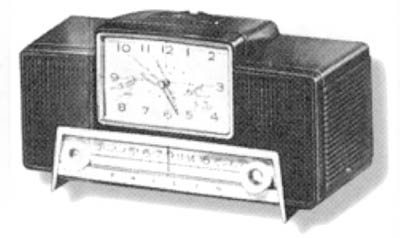Of Old Radios And Related Items--Published Monthly
Repairing a Philco G751-124
By Bill Thomas
Web Edition
Should you repair or trash an inexpensive radio? Bill Thomas tells about his decision and the repair of a Philco clock radio. (Editor)
Readers may be interested in my recent experiences in repairing a 1959 Philco G751-124 AC/DC "All American 5" plastic clock radio, shown in Figure 1, which I bought for $2.50 from a flea market. For that price, my intentions were to salvage the tubes, the knobs, and maybe the speaker. The effort quickly turned into an academic exercise; i.e., it took more effort than the results justified.
Starting off
First of all, the clock ran but the tubes did not light up. Using tube basing diagrams from an old GE tube manual, which has lost its plastic binder and is kept in a plastic bag, as well as a multimeter, I found that both the 50C5 and the 35W4 had open filaments. Note: The 35W4 has a tap on the filament for a pilot lamp, and there should be continuity between three pins, not two. Half of the filament was open.
The 12AV6 was found to have one pin broken off in the socket. The pin had to be removed with needle nosed pliers. The 12BA6 and the 12BE6 tested good on my Hickock model 600 tube tester, as did the three replacements from my junk box for the 50C5, the 35W4, and the 12AV6.

Figure 1. The 1959 Model G751-124 "All American 5" plastic clock radio. Photo from "Machine Age To Jet Age III" by Mark V. Stein.
When I used a cheater cord and an isolation transformer to power up the chassis, now removed from the cabinet and disconnected from the clock, nothing happened. Power to the radio chassis feeds through the clock through edge card contacts in the plastic cabinet. No clock, no radio!
Using a clip lead, I jumpered the appropriate contacts, and plugged in the chassis. Fourth of July! Wrong contacts! Two circuit board traces, to the line cord connector, had vaporized. After repairing the trace damage, I carefully determined the correct edge card connectors to jumper, and soldered a wire across them for the experimental phase.
Applying power, and allowing for warm-up, the radio played very well, and was blasting out WWL in New Orleans. After about five minutes, distortion began to increase and volume decreased. I checked all the tubes for mutual conductance and shorts after warm-up. All were OK. Again, distortion and low volume after about five minutes.
On a hunch I tried another 50C5 from the junk box and played the radio for at least ten minutes with no distortion or loss of volume. Replacing the 50C5 with my first choice had recreated the problem. Again to the tube tester, and extended cooking time. Nothing. Good transconductance and no shorts. Both tubes tested exactly alike yet one worked and the other only lasted five minutes.
Back to the book
I reread the manual on the tube tester and ran a gas test on the two tubes. The bad tube had a very high gas reading, the good tube none. Gas, either from trapped molecules or from a seal leak, causes positive ions, which instead of boiling off the cathode, are attracted to it, eventually causing cathode damage. Why the transconductance reading was not affected I do not know. I will have to research it. I do know that I will be running the gas test more often in the future.
The radio plays pretty well, and has been added to the collection. Scrapping it at this point brings on questions of euthanasia.
Reference:
Stein, Mark V. Machine Age To Jet Age III. Baltimore: Radiomania Publishing, 1999, p. 163.
(Bill Thomas, 1005 Elberta Rd., No. 106, Warner Robins, GA 31093-1767)
Bill Thomas, a civilian electronics engineer specializing in military communications equipment, has been interested in radio since receiving a Crosley 52 and a Radiola III at age 14. His collection features radios of the 1920s to mid-1930s, including a classic RCA RC complete with WD12 tubes, among other models of the period.
| [Free Sample] [Books, etc., For Sale] [Subscribe to A.R.C./Renew] [Classified Ads] [Auction Prices] [Event Calendar] [Links] [Home] [Issue Archives] [Book Reviews] [Subscription Information] [A.R.C. FAQ] URL = http://www.antiqueradio.com/Nov02_Thomas_Philco.html Copyright © 1996-2002 by John V. Terrey - For personal use only. Last revised: November 3, 2002. For Customer Assistance please contact ARC@antiqueradio.com or call (866) 371-0512 Pages designed/maintained by Wayward Fluffy Publications
Antique Radio Classified |